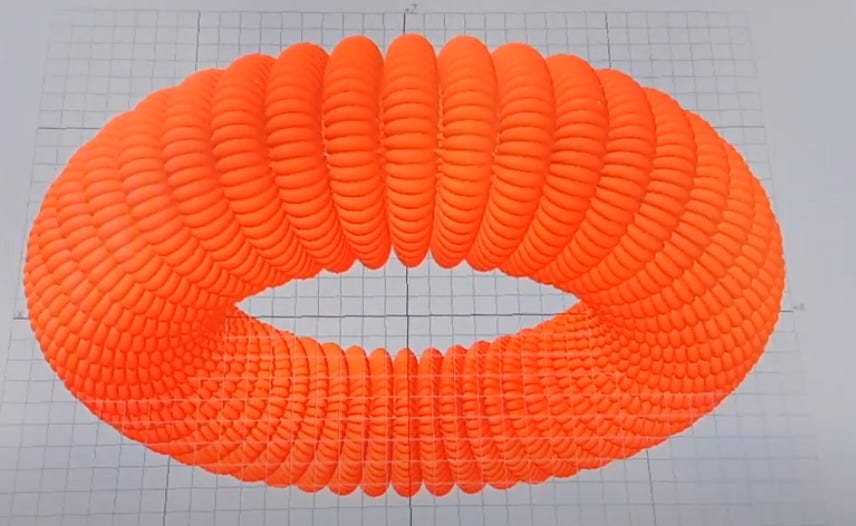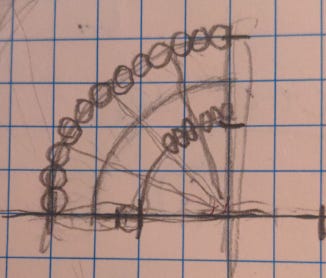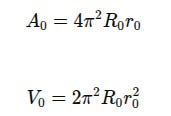Fractal Toroids - Part 1, Geometry
The plural of torus is tori

Following on Bob Greenyer’s work, I want to examine the fractal nature of the torus-within-a-torus-within-a-torus…

This structure is important for LENR research. If you want to catch up on Bob’s work on this, start here and branch out as needed.
The Area and Volume of Breaking a Torus into Many Smaller Tori
As we create another level, and make each torus to be built up of many tori perpendicular to the first, what happens to the overall volume, area, and can we assign any kind of a fractal dimension?
We start with the “D, 4D” structure, where the width of the tube is 1/4 the width of the entire doughnut. This is seen experimentally.
Gotta love those formulas for area & volume. They seem too simple. Give subscripts, to keep track of things, let zero be the starting torus,
When we replace the original torus by a number of smaller torus, and preserve the same proportions, where everything about the smaller tori is 1/4 that of the larger. R_0 = 3r_0, and r_1 = 1/4r_0. See my Figure 1 above. Each new smaller torus_1 has 1/16 the area, and 1/64 the volume of the larger torus_0. You can work it through the above formulas, or think that shrinking something to 1/4 the original will make the new area 1/4 * 1/4 = 1/16 the original; and the volume to 1/4 * 1/4 * 1/4 = 1/64 the original.
We must of course decide how many smaller torus are used to replace the larger. Going with Bob’s number of 48, each time we create a new smaller level, the total surface area increases by 3x, and the total volume reduced to 3/4 the original. Because the area of the smaller torus is 1/16 the larger, and we have 48 of the smaller, so the total is 48 * 1/16 = 3 times the original. The volume of each smaller torus is 1/64 the original, so the total volume is 48 * 1/64 = 3/4 the original.
This is very interesting. But first,
I am exploring this because I expect that each new layer is created in response to more energy input to the system, and that the energy increase will be quantized. I want to have some model prediction for the steps of energy quantization, and then devise experiments to look for that step-wise increase.
I don’t know yet whether new layers are created by sub-dividing the first layer, or by creating a new larger torus where a number of the first join together in to a ring 4x larger.
Theory says that once you have 3 levels, the E & B fields will be self-contained, and not propagate to the outside world. This amazing feature is why future E&M students are going to study hyper-torus systems, and learn all about toroidal magnetic moments. It still amazes me that my graduate level physics education did not mention anything about this.
Exploring point 2 above, and keeping the model that 48 smaller tori make up the larger: If a new level is created by sub-dividing the starting torus, then the new structure has 3x the area and 3/4 the volume. Continuing this, as you create smaller and smaller sub-structures, the total area will grow without limit, and the total volume will head towards zero. Strange.
Dividing one large torus into 48 smaller does not work out very well without severely distorting the shapes. 48 proportionately smaller tori will fit along the OUTSIDE of the original, but they must be greatly smooshed as you head towards the center.

Splitting into 32 smaller tori works much better, as far as drawing pictures.
Using 32 smaller sub-units results in a new sub-structure having area total is 32 * 1/16 = 2. For the volume, 32 * 1/64 = 1/2. In other words, the area still grows with each sub-layer, and the volume still decreases. I am not commenting on what we observe in experiments, just commenting on the geometry of the model.
The Fractal Dimension
The simplest way to assess the dimension of such objects is through what is known as the Hausdorf Dimension.
D = log(how much more stuff you get when) /
log(you increase the linear size by some amount)
Take an example from our ordinary 3-dimensional world. If we start with a ball of diameter 1”, then get a box that is 4x larger in each direction, that is 4” x 4” x 4”, then we can fit 64 balls into this bigger box.
D = log(64) / log(4) = 3
This system has a dimension of 3, which is just a description of the ordinary 3-dimensional world we live in.
In our torus model, we create a new torus that is 4x larger, and fill it with 48 of the smaller tori, hence the Hausdorf Dimension is
D = log(48) / log(4) = 2.8
If we say the new torus is composed of 32 of the smaller, the dimension is
D = log(32) / log(4) = 2.58
For me, this addresses the dimension of the volume of the object. I need to think more about what is happening to the surface area.
Next
In the next post I will look at the energetics of this model.







Bob Greenyer and I have been cooperating for years on interpreting his experimental findings. We has a few points of contention, namely the particle that forms the EVO and the structure that particle forms. Bob concedes that the matter inside the plasmoid is coherent but he does not explain how that matter becomes coherent. On this point coherence is produced through Bose Einstein condensation. Bob recognizes that the plasmoid produces a zone of hexagonal magnetic polarization around the mature plasmoid, but he does not explain how that zone is produced. This effect is produced by the surface magneto-optic Kerr effect (SMOKE) when the hexagonal supersolid lattice formed by the exciton polaritons imparts a particle spin based huge magnetic force onto the metal surface which changes the off-diagonal components of the dielectric tensor of the metal. These off-diagonal components give the magneto-optic material an anisotropic permittivity, meaning that its permittivity is different in different directions. This anisotropic permittivity becomes visible under polarized light. The polariton hexagonal lattice structure seems to coexist concurrently with the petal structure of the condensate. Furthermore, the dipolar vortex flux tubes are recognized to exist in polariton research and are well characterized but Bob has not shown how the electron circulation of many segmented dipole magnetic structures can produce this singular tube configuration.
Bob’s experimental data includes the observation of a demarcation boundary that forms a bubble that the plasmoid is enclosed within. This takes the form of a hollow sphere of crenelated transmuted matter. You have seen this in the sphere of rare earth elements transmuted in the SAFIRE system. This sphere is an artifact of the domain wall that forms when a negative false vacuum state is nucleated. Nucleation is the process by which a "bubble" of the negative energy vacuum state begins to form within the ambient vacuum, essentially marking the start of the decay of the negative vacuum into an unstable state; this bubble formation is considered the key mechanism of false vacuum decay and is referred to as "bubble nucleation. The Exciton polariton condensate (BEC) has recently been shown to produce negative vacuum energy through the action of its dispersion channel. The BEC is able to convert the vacuum state that it exists within to a negative vacuum state. All of the unworldly properties of the plasmoid come from this condition such as how a condensate can exist in plasma.
The plasmoid formed by electrons cannot explain how huge amounts of high energy photons are produced as a continuing output of the plasmoid. The plasmoid is known to express in both a bright and black state. The polariton condensate has been characterized to express in this mode of continuous high energy light production.
Usually no nuclear radiation is seen arising in the transmutation that occurs in LENR, but when the reaction is weak gamma radiation has been detected. This behavior is produced by the temperature that develops inside the domain wall bubble produced by the spins of the polaritons. The temperature at which electroweak unification occurs is significantly higher than the temperature at which quark-gluon plasma is produced; the electroweak unification temperature is estimated to be around 10^15 Kelvin, while quark-gluon plasma formation happens at a much lower temperature, around 10^12 Kelvin. The gamma radiation comes when the temperature of the condensate inside the domain wall is between 10^12 and 10^15 Kelvin. After the temperature inside the bubble exceeds 10^15 Kelvin and electroweak unification is achieved, then transmutation no longer produces gamma radiation.
I will stop now but there is more, namely how the vacuum inside the domain wall is transformed to a negative energy state by the condensate and how the plasmoid is created inside the plasma.
Dear Michael,
Thank you for looking at this important and valuable aspect of these Fractal Magneto-Hydrodynamic structures. Don't beat yourself up about not being taught the Toroidal Moment, it was not even recognised in the west until 1997, which was after my higher education had ended too.
I firmly believe that, just like the wide range of phi ratios embedded into the overall structure, many of the other relative area/volume/length aspects will reveal themselves in the data as predictive.
A similar treatment looking at the inner surface and volume of the lemon, the outer surface of the apple and the total volume of the inner part of the sub-cores would be very helpful (the inner surface of a sub-core is bounded by the apple of the MHD structures below).
A fractal tor appears to have a minimum of 2 sub tors per level and a maximum of 48 sub tors with the latter based on experimental observations and more, some of which given below.
15 Feb 2020, MFMP 2007 Hutchison Al sample "Fracture" - four quantised scales, the n-3 and n-2 were not easy to resolve optically. The n-1 scale appeared to have 6 sections and the n level had 48. https://youtu.be/yw15QYXqva8
1 Apr 2020 - Super NOVA (George Egely microwave dusty plasma ball lightning reactor) - EVO ONE - https://youtu.be/cAFNgYqj0vU
16 Nov 2022 - VEGA - Marks of EVO action on cathode in “Cardioid Infarction experiment” - https://www.youtube.com/watch?v=s93spNJMmdM
The 'Flying Disc of the Sky Gods' on Sumerian Stela of Shamshi Adad 814 BC (showing belief from 1000 years or more before) https://remoteview.substack.com/p/practical-applications-of-the-fractal-87d
Physical impacts of Fractal MHD structures on Fused Quartz tube from Jurrien VEGA experiment https://remoteview.substack.com/p/the-mark-of-an-exotic-vacuum-object and https://remoteview.substack.com/p/becoming-clear
13 May 2022 - Collapsed matter deposits indicating up to 48 in Jurrien VEGA experiments https://remoteview.substack.com/p/vega-bagel-mania
Matsumoto (various up to 48 at n-level and multiple sub levels revealed in Strasburg presentation) https://remoteview.substack.com/p/extraordinary-repeatable-evidence-0c4
Lockheed Martin's MHD based propulsion craft have 48 capacitor banks.
A close runner up wast the 47 sub-tors represented on the grand masters battle shield in the armoury in Valletta in Malta. - https://remoteview.substack.com/p/extraordinary-repeatable-evidence-0c4
I too argue that they subdivide as they accrue more energy, I think of it as a bit like winding a string where kinks become more kinky but lock into orthogonal arrangements. This is where my model of ball lightning departs from Paul Koloc's, the thought helicity would cause a 90º kink that would break off horizontal to the pinch, I think that it kinks 180º to the pinch at each fractal level before breaking off - so helicity leads directly too a tor of tors.
My best guess at why 48 is the limit, is that the sub-cores internal volume, bounded by the sub-sub apples event horizon (which we have shown in Huang reactor analysis and VEGA can be very disruptive) does not interact until trying to go above 48, at which point the overall structure has two choices, divide or otherwise disrupt. I have argued that this disruption is the cause of branching in lightning and Lichtenberg figures.
https://remoteview.substack.com/p/o-day-48-and-cone
From observation, I would argue that growth takes place only by aggregation, this can be at the bottom end, by feeding it photons or matter, including electrons - and at the upper end, by aggregation of already formed clusters, which depends on if they are bound to a surface (like metal) where they wet together their non-radiating boundary and later merge as they divide or they are in free space, where they can entrain each other by their spin fields and beams and if coincident enough (either practically head on or coming from behind or from side if below 6 sub tors) merge.
I too argue that the more energy that is incorporated into the structure, the more it winds. I consider it a bit like